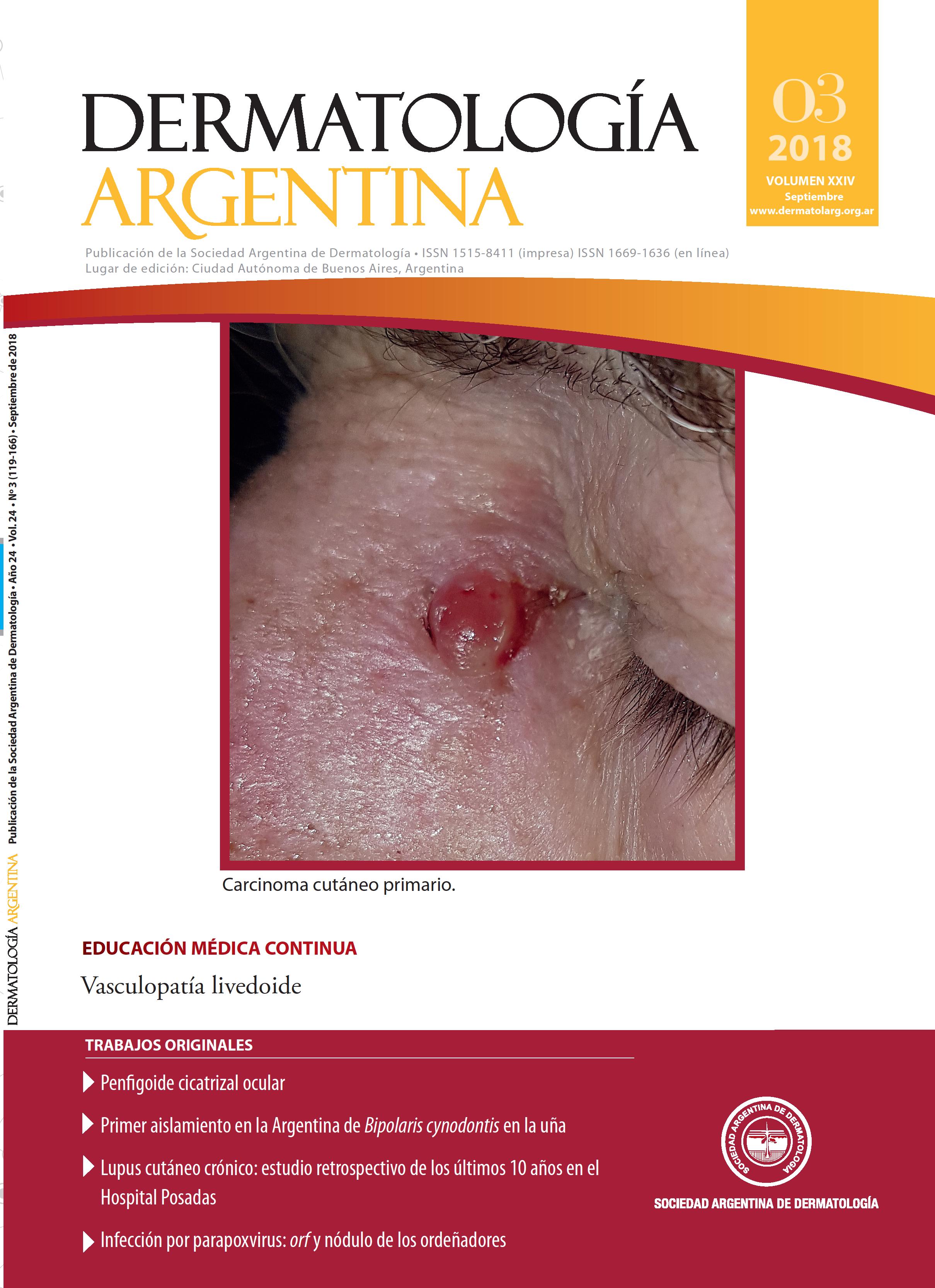Poxviruses infection: orf and milker’s nodule
Keywords:
Orf virus, milker’s nodules, contagious ecthyma, parapoxvirusAbstract
Orf and milker’s nodules infection are both zoonotic contagious diseases that mainly affect cattle. They are caused by dermotropic parapoxviruses. Human infection is an occupational disease for these who handle infected animals. We present three cases of human parapoxvirus infection, orf and milker’s nodules, seen in the hands of individuals who were occupationally exposed. It is important to consider this entity in the differential diagnosis of hand lesions with epidemiological background.
References
I. Barraviera S. Diseases caused by poxvirus–orf and Milker’s nodules. A review. J Venom Anim Toxins Incl Trop Dis 2005;11:102-108.
II. teinhart B. Orf in humans: dramatic but benign. CJEM 2005;7:417-419.
III. Bodnar M, Miller O, Tyler W. Facial orf. J Am Acad Dermatol1999;40:815-817.
IV. Werchniak AE, Herfort OP, Farrell TJ, Connolly KS, et ál. Milker’s nodule in a healthy young woman. J Am Acad Dermatol2003;49:910-911.
V. Bergqvist C, Kurban M, Abbas O. Orf virus infection. Rev Med Virol 2017; 27:1-9.
VI. Li W, Ning Z, Hao W, Song D, et ál. Isolation and phylogenetic analysis of orf virus from the sheep herd outbreak in northeast China. BMC Vet Res 2012; 8:229.
VII. Uluğ M, Ürer MS, Bilgili ME, et ál. A viral infection of the hands: orf. J Microbiol Infect Dis 2013;3:41-44.
VIII. Uzel M, Sasmsz S, Bakaris S, Cetinus E, et ál. A viral infection of the hand commonly seen after the feast of sacrifice: human orf (orf of the hand). Epidemiol Infect 2005;133:653-657.
IX. Zhang K, Shang Y, Jin Y, Wang G, et ál. Diagnosis and phylogenetic analysis of Orf virus from goasts in China: a case report. Virol J 2010;7:78.
X. Ferrando MF, Léauté-Labrèze C, Fleury H, Taïeb A. Orf and erythema multiforme in a child. Pediatr Dermatol 1997;14:154-155.
XI. Mourtada I, Le Tourneur M, Chevrant-Breton J, Le Gall F. Human orf and erythema multiforme. Ann Dermatol Venereol 2000;127:397-399.
XII. Baillis B, Maize J. Treatment of recurrent erythema multiforme with adalimumab as monotherapy. JAAD Case Rep 2017;3:95-97.
XIII. Requena L, Requena C. Histopathology of the more common viral skin infections. Actas Dermosifiliogr 2010;101:201-216.
XIV. Li Y, Meyer H, Zhao H, Damon IK. G+C content based universal PCR assays for poxviruses detection: “Pan_Pox”. J Clin Microbiol 2010;48:268-276.
XV. Geerinck K, Lukito G, Snoeck R, De Vos R, et ál. A case of human orf in an immunocompromised patient treated successfully with cidofovir cream. J Med Virol 2001;64:543-549.
XVI. Erbagci Z, Erbagci I, Almila Tuncel A. Rapid improvement of human orf (ecthyma contagiosum) with topical imiquimod cream: report of four complicated cases. J Dermatolog Treat2005;16:353-356.
XVII. Lederman ER, Green GM, DeGroot HE, Dahl P, et ál. Progressive ORF virus infection in a patient with lymphoma: successful treatment using imiquimod. Clin Infect Dis 2007;44: e100-3.
XVIII. Ara M, Zaballos P, Sánchez M, Querol I, et ál. Giant and recurrent orf virus infection in a renal transplant recipient treated with imiquimod. J Am Acad Dermatol 2008;58: S39-40.
XIX. Degraeve C, De Coninck A, Senneseael J, Roseeuw D. Recurrent contagious ecthyma (orf ) in an immunocompromised host successfully treated with cryotherapy. Dermatology1999;198:162-163.
Downloads
Published
Issue
Section
License
Copyright (c) 2018 Argentine Society of Dermatology

This work is licensed under a Creative Commons Attribution-NonCommercial-NoDerivatives 4.0 International License.
El/los autor/es tranfieren todos los derechos de autor del manuscrito arriba mencionado a Dermatología Argentina en el caso de que el trabajo sea publicado. El/los autor/es declaran que el artículo es original, que no infringe ningún derecho de propiedad intelectual u otros derechos de terceros, que no se encuentra bajo consideración de otra revista y que no ha sido previamente publicado.
Le solicitamos haga click aquí para imprimir, firmar y enviar por correo postal la transferencia de los derechos de autor











